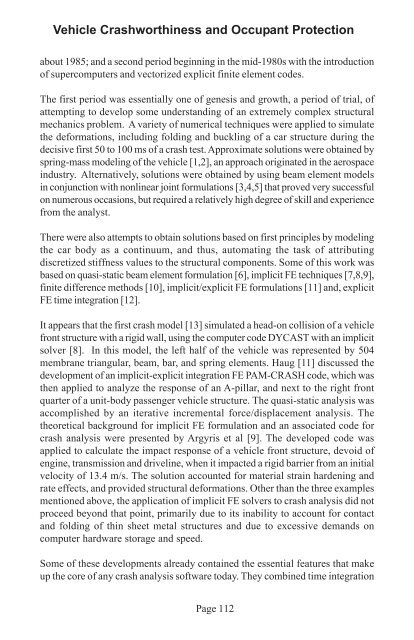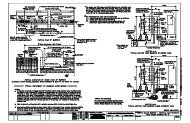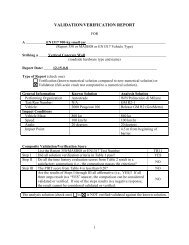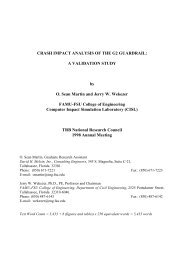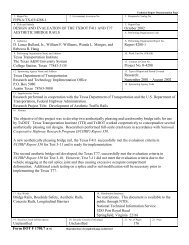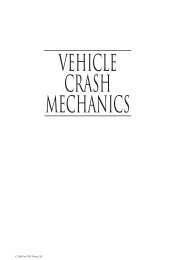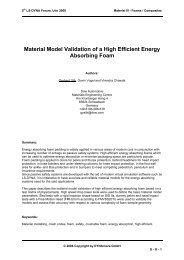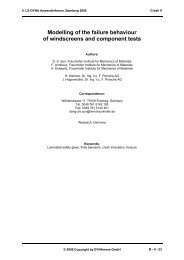Vehicle Crashworthiness and Occupant Protection - Chapter 3
Vehicle Crashworthiness and Occupant Protection - Chapter 3
Vehicle Crashworthiness and Occupant Protection - Chapter 3
You also want an ePaper? Increase the reach of your titles
YUMPU automatically turns print PDFs into web optimized ePapers that Google loves.
<strong>Vehicle</strong> <strong>Crashworthiness</strong> <strong>and</strong> <strong>Occupant</strong> <strong>Protection</strong><br />
about 1985; <strong>and</strong> a second period beginning in the mid-1980s with the introduction<br />
of supercomputers <strong>and</strong> vectorized explicit finite element codes.<br />
The first period was essentially one of genesis <strong>and</strong> growth, a period of trial, of<br />
attempting to develop some underst<strong>and</strong>ing of an extremely complex structural<br />
mechanics problem. A variety of numerical techniques were applied to simulate<br />
the deformations, including folding <strong>and</strong> buckling of a car structure during the<br />
decisive first 50 to 100 ms of a crash test. Approximate solutions were obtained by<br />
spring-mass modeling of the vehicle [1,2], an approach originated in the aerospace<br />
industry. Alternatively, solutions were obtained by using beam element models<br />
in conjunction with nonlinear joint formulations [3,4,5] that proved very successful<br />
on numerous occasions, but required a relatively high degree of skill <strong>and</strong> experience<br />
from the analyst.<br />
There were also attempts to obtain solutions based on first principles by modeling<br />
the car body as a continuum, <strong>and</strong> thus, automating the task of attributing<br />
discretized stiffness values to the structural components. Some of this work was<br />
based on quasi-static beam element formulation [6], implicit FE techniques [7,8,9],<br />
finite difference methods [10], implicit/explicit FE formulations [11] <strong>and</strong>, explicit<br />
FE time integration [12].<br />
It appears that the first crash model [13] simulated a head-on collision of a vehicle<br />
front structure with a rigid wall, using the computer code DYCAST with an implicit<br />
solver [8]. In this model, the left half of the vehicle was represented by 504<br />
membrane triangular, beam, bar, <strong>and</strong> spring elements. Haug [11] discussed the<br />
development of an implicit-explicit integration FE PAM-CRASH code, which was<br />
then applied to analyze the response of an A-pillar, <strong>and</strong> next to the right front<br />
quarter of a unit-body passenger vehicle structure. The quasi-static analysis was<br />
accomplished by an iterative incremental force/displacement analysis. The<br />
theoretical background for implicit FE formulation <strong>and</strong> an associated code for<br />
crash analysis were presented by Argyris et al [9]. The developed code was<br />
applied to calculate the impact response of a vehicle front structure, devoid of<br />
engine, transmission <strong>and</strong> driveline, when it impacted a rigid barrier from an initial<br />
velocity of 13.4 m/s. The solution accounted for material strain hardening <strong>and</strong><br />
rate effects, <strong>and</strong> provided structural deformations. Other than the three examples<br />
mentioned above, the application of implicit FE solvers to crash analysis did not<br />
proceed beyond that point, primarily due to its inability to account for contact<br />
<strong>and</strong> folding of thin sheet metal structures <strong>and</strong> due to excessive dem<strong>and</strong>s on<br />
computer hardware storage <strong>and</strong> speed.<br />
Some of these developments already contained the essential features that make<br />
up the core of any crash analysis software today. They combined time integration<br />
Page 112


